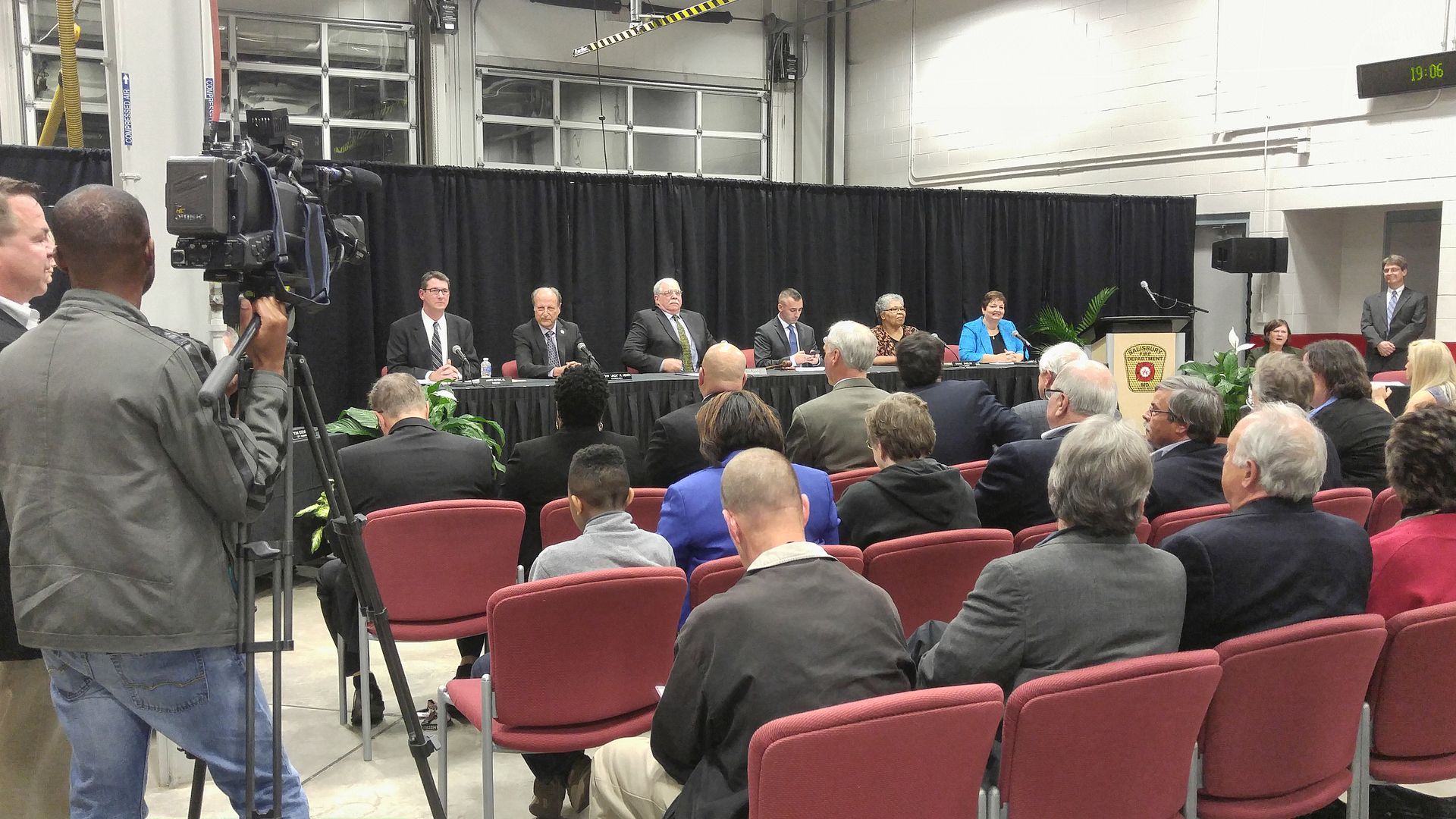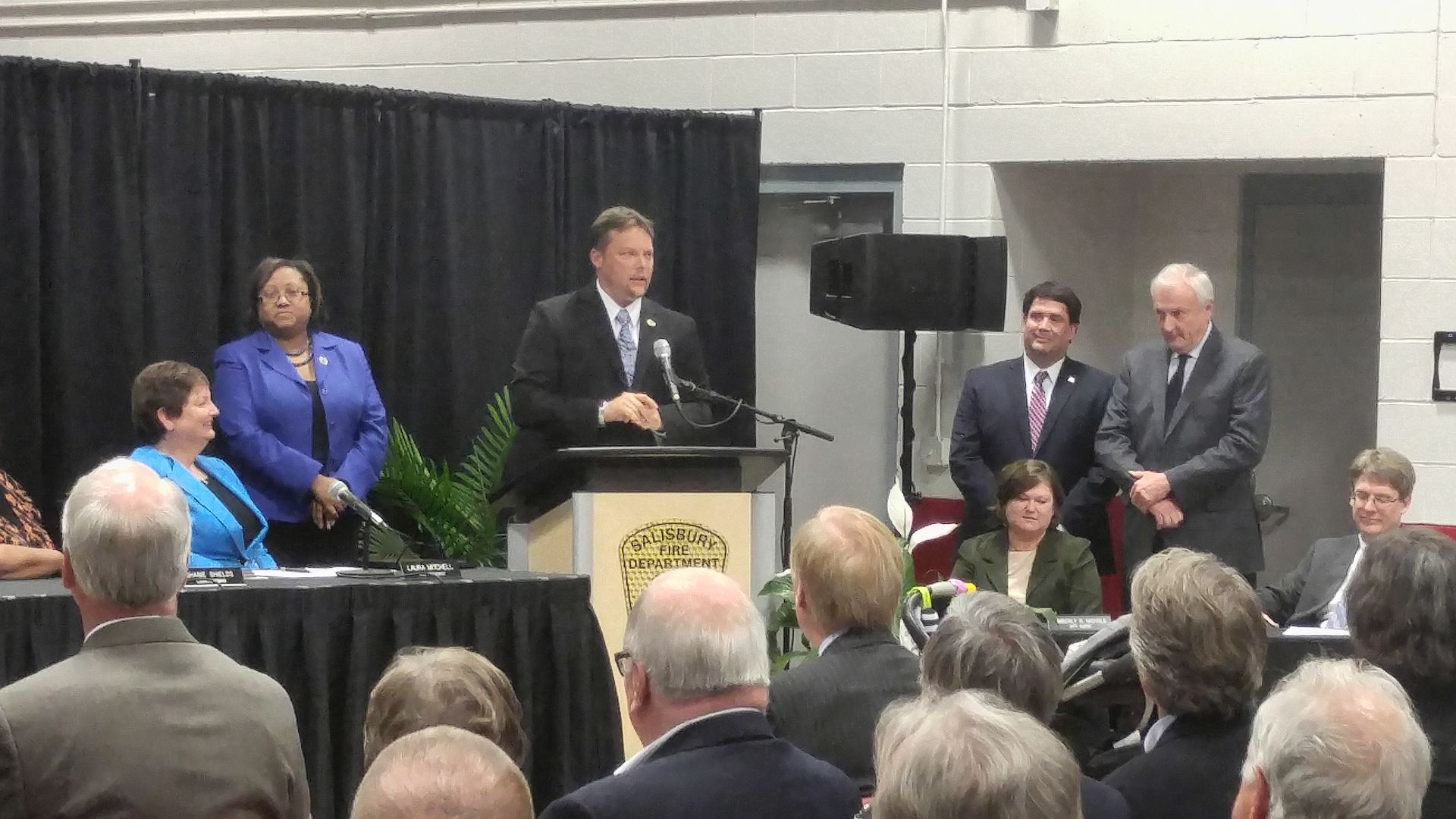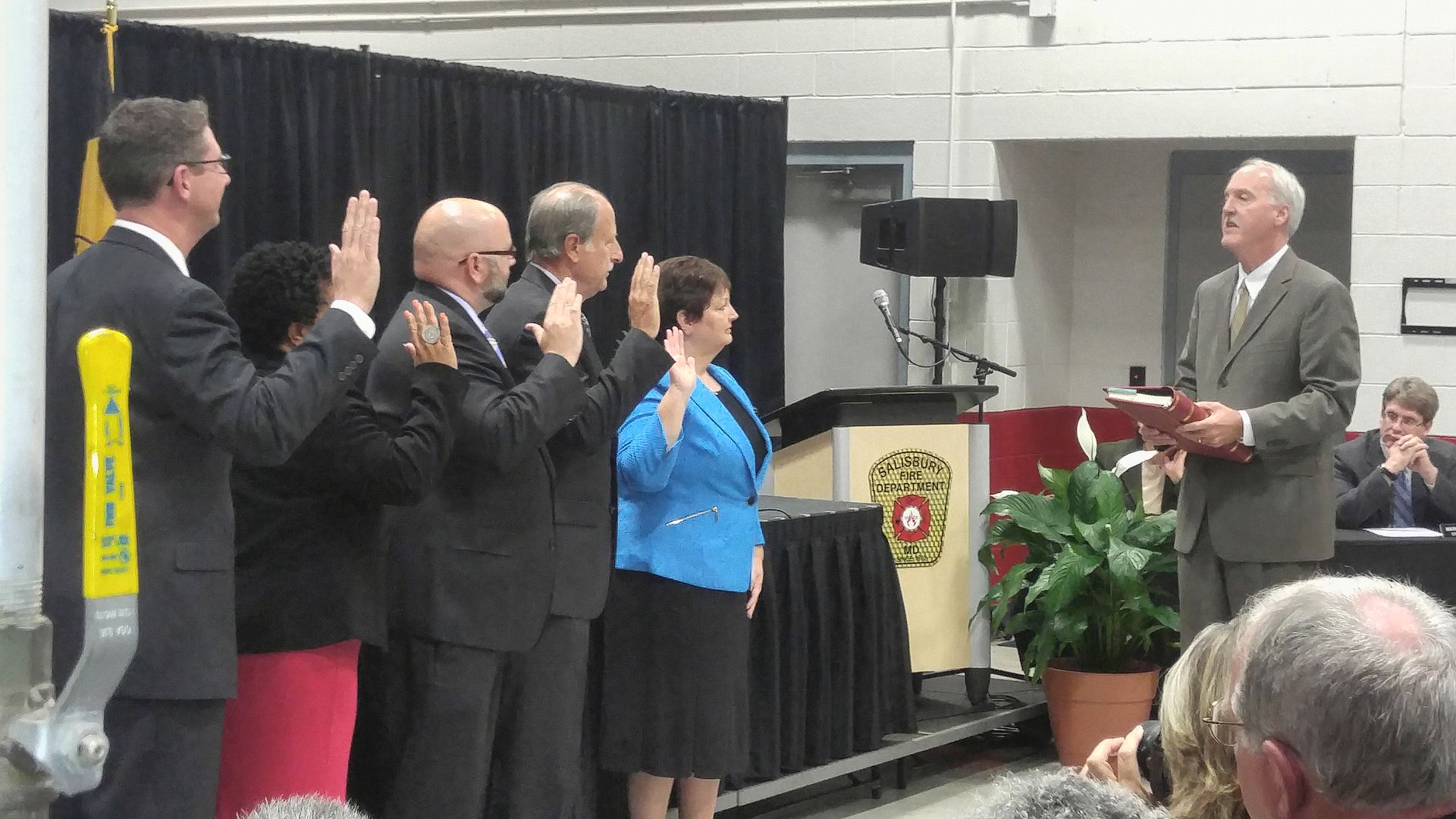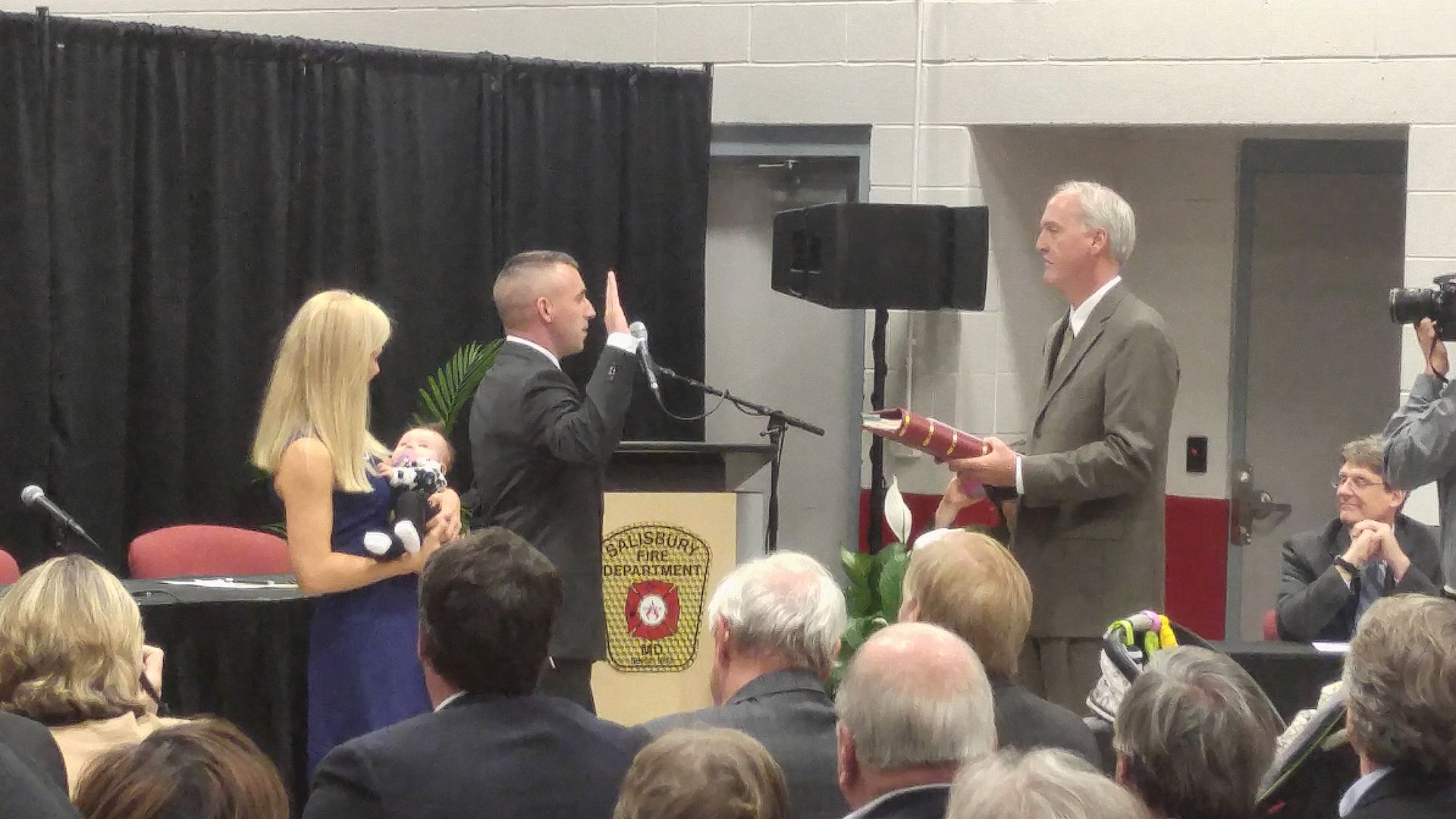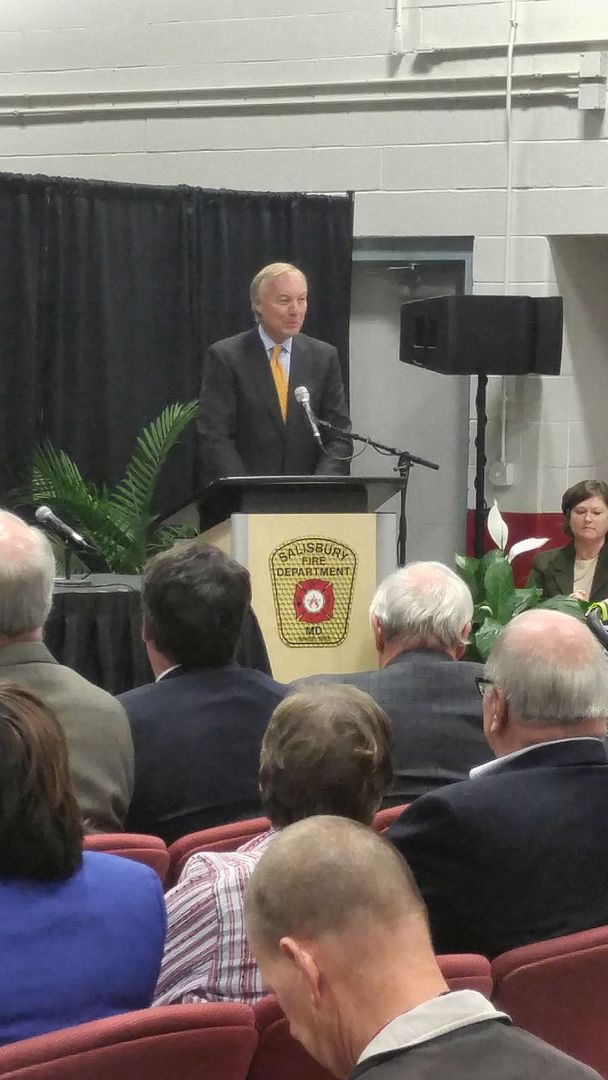Normally I try to do a blow-by-blow of these events by question but instead this time I want to do it by candidate. Many of the questions concerned an issue I also think is paramount, and that’s economic development. Small wonder when the local Chamber of Commerce is the co-sponsor.
And as an executive editorial decision, summarizing by candidate also gives me the opportunity to comment on their final release of financial statements prior to the election.
I want to begin with District 1, a fight in which I have no dog in because I live in the city’s other district. Through a quirk in the City Charter, we found out the primary election did nothing but act as a poll as to relative position in the race. We found both April Jackson or Cynthia Polk would need to find perhaps 80 to 85 votes to get to victory while Shanie Shields only needs around 60 (based on 2009 results, where just over 250 total votes were cast.) But District 1’s pathetic turnout means it’s quite possible the first to 100 votes wins.
I’ll begin with April Jackson, who attended this forum after missing the PACE event in February and almost missing the cutoff in the primary. Her 53rd and tying vote was practically the last one counted in the final canvass.
Her business vision was one of creating a five-year plan to bring in business and tourism, stating “I have no doubt in my mind” the city could succeed. Among the successes she would like to work on if elected is the North Prong/Lake Street neighborhood, something which is currently “a complete eyesore” but could be revitalized.
April also felt that the way to a better business environment was to find out what the city wants or needs. But something the city didn’t need was the enhanced disclosure form argued about by City Council, a document Jackson called “totally unnecessary” and “not feasible.” Moreover, she believed we do need a full-time city attorney.
She also contended, on the question of consolidating city and county services, that we should all work together – I gathered she was more open to the idea than most. In the end, Jackson advocated for a clear vision, smart planning, and open dialogue and vowed to serve with “dignity, direction, and determination.”
Through two reports Jackson has raised just $945, with most of it apparently coming from supportive family and friends. Her chief expenditures have been signage and a radio ad running on local gospel station WDIH-FM.
Fellow challenger Cynthia Polk pledged to bring “the power to listen” to City Council, advocating herself for “active listening.” Yet while she spoke about “the power of no,” Cynthia noted that “every no don’t mean no,” quoting her grandmother. And even on the question of a full-time city attorney, she was noncommittal: “I would have to go and listen.”
She was more decisive about and critical of the much-discussed disclosure form, though, calling it a “borderline invasion of privacy.” Polk was “leery” of exceeding the state requirements for disclosure on a city form. She was also concerned about the consolidation of services with the county, citing the level of service and the budget as factors.
However, Cynthia was willing to create jobs – her “top priority” – through collaboration with local universities and expanding the enterprise zones to include more of District 1. She also pondered how we could attract more Ocean City-bound traffic and tourism – but she seemed a little bit hesitant to embrace mayoral candidate Joe Albero’s claim he would double as the city’s economic development director, jumping in on a mayoral question to note economic development “is a specialty.”
Polk did believe the River’s Edge project, which is near her home, would “give the whole area a lift.” The city needs innovation, and an opportunity to restore that area to the prominence it once had instead of the question “why do you live over there?” Cynthia noted in her closing her shortcomings as a public speaker, but that answer proved she could speak clearly and passionately when needed. “I’m the candidate for the rest of us,” she concluded.
After not filing a full financial report in the primary because she didn’t meet the $600 threshold, Polk revealed she had raised $550 – exactly half of that self-funded – and spent most of her funds on signage. She’d also leaned heavily on three volunteers for distributing the flyers, claiming 34 hours of in-kind services from them at $8 per hour. (One of those volunteers and contributors was former City Council member and 2010 Delegate candidate Von Siggers.)
Incumbent Shanie Shields could obviously lean on her eight years on City Council, but opened up by saying she was “ready to move Salisbury forward.” But two things she wanted in her next term were “a better political climate” and “civility” – for her, the last two years have been “stressful.”
Indeed, she was very critical of the current rendition of City Council. Citing the disclosure form as an example, she revealed it was just 23 taxpayers who wanted the ordinance, with two bothering to testify. It’s “another example of not including stakeholders,” according to Shields. “We need to bring stakeholders to the table,” she would later stress in response to another query.
A second bone of contention with the city’s legislative body was the city attorney. Shields jumped on a statement by District 2 challenger Jake Day about the city attorney, charging that the city hadn’t seen a legal bill since October. “If the previous city attorney had done that we would have his head,” Shanie charged.
On the mayoral question of a full-time economic development director, Shields added her remark that she couldn’t support the hiring of one before other current city workers received raises. Her budgetary concerns extended to the idea of consolidating services with the county, a concept she believed could be handled through mutual aid pacts. Like Jackson, Shields advocated for the idea of developing the North Prong, adding in the concept of extending the existing Riverwalk to that area. She also believed the area of Germania Circle should be converted over to a park, citing how flood-prone it has been.
Not surprisingly, the incumbent has raised the most money in the race, a total which has now reached $3,170. Much of that has come from the building and rental industry – local architect Keith Fisher, realtor Michael Weisner, GNI Properties, and Investment Properties are among contributors which donated at or near the maximum $250 limit. And while she’s spent her money on the regular campaign fare of signs, radio spots, and a handful of shirts, Shanie should also be commended for spending a little bit on feeding her volunteers.
Yet while the District 1 contenders chose to try and sell themselves, the two District 2 candidates who survived the primary were running against something: Jake Day against a Council which he claims needs more collaboration and openness and Debbie Campbell against an opponent versus whom she’s several hundred votes in arrears.
Jake Day, as the leading primary vote-getter, could afford to lay back and call out the need for a business environment that’s “all about collaboration, all about openness.” That included reducing barriers to investment, creating an EDU-free zone, and “making an investment in” an economic development office and business incubator. On the other hand, when the subject of Urban Salisbury came up before the mayoral debate, Day added his belief that Urban Salisbury wasn’t structured right nor was it focused on the right things.
His vision for downtown was one with mixed-use development, something which could be worthy of being called “the capital of the Eastern Shore.” It takes a changed culture, though.
Jake was critical of the disclosure form, decrying the $1200 of city staff time in arguing over the points of an “absurd ordinance,” but one which is a “good idea, executed poorly.” Day also pointed out these and other ideas, like a proposed “lockout law”, came before Council thanks to its president, which served as a subtle dig at Council as composed. That extended to the expenditure of $110,000 Jake claimed had been spent on a city attorney. The 2,500 voters who signed a petition to revisit the city attorney question were right, added Jake. And when questioned about the 2,500 signatures by opponent Debbie Campbell, who pointed out they weren’t certified, Day said “I knocked on doors using that list.” He added that “the county is in a great place” with its internal counsel.
But on other questions, Jake was more receptive. “We have to keep our mind open” to the possibility of combining city and county services if it’s efficient.
In his closing statement, Day pointed out this would be the last gathering of the candidates. “This has been an incredible experience,” he said, adding his admiration for former Council aspirant Jack Heath. When we set our sights on goals, we have the people to accomplish them, Day concluded.
Financially, Day eclipsed the five-figure mark in his latest statement, raising $10,535 thus far and leading all candidates. Included in that was $250 in PAC money from the Realtors PAC in Annapolis. Day has also spent the most on radio ads and fundraisers of any Council candidate, by far.
On the other hand, and by virtue of her distant second-place primary finish, Debbie Campbell had to be more aggressive in her approach to the forum.
She repeated her belief that businesses trying to engage the city should be treated like they’re checking into a five-star hotel, and reminded voters that there had been no tax increase “yet.”
On the subject of the disclosure form, though, Debbie saw it as a way of addressing the “veil” of LLCs over public money. It “creates transparency,” she argued. This contentiousness extended to the mayoral discussion of a proposal to adopt a more stringent “lockout law.” Campbell contended it could be enforced for an unregistered firearm, and the idea was from the mayor’s office.
Debbie also chimed in on a question which turned to the subject of Urban Salisbury, making the contention that they funded the organization “for years” but never saw the desired results. “Sometimes ‘no’ isn’t the popular answer, but it is the right answer,” said Campbell.
She also spoke at some length about the consolidation of services, reminding the audience of about 75 that “the political will did not exist” to keep the human resources and IT departments together between city and county. She also noted that consolidating public safety was “deemed not sensible” but “perhaps” the public works departments could be combined.
Debbie’s vision for the city was one of increasing our tax base, stating that “we don’t need more subsidized housing.” While we have “righted the ship,” said Campbell, we still need good jobs. She was also proud of the River’s Edge project.
Toward the end of the forum, though, Campbell became more critical of her opponent. Holding up a highlighted copy of Jake Day’s 44-page plan for the city, Debbie charged “everything in green (highlighter) costs money…you have to have somebody to say you can’t afford it.” Interestingly enough, that plan is no longer available online. (Apparently there was an issue with access from certain browsers. Jake let me know it was working, and I verified this afternoon.) But I have the (non-highlighted) draft copy.
[gview file=”http://monoblogue.us/wp-content/uploads/2013/03/Our-Vision-for-Salisbury-Jake-Day.pdf”]
She also believed the question of a fulltime city attorney needed to be studied on a cost/benefit basis, where she alleged the 2,500 signatures were not certified. (They weren’t because the threshold for petitioning to an election in the city requires more than 2,500 signatures.)
Debbie’s key point was her status as a fiscal watchdog – “I’ve watched your money,” said Campbell – but she was also critical of the PAC money Day has received. Holding up copies of a mailing paid for by the National Association of Realtors Fund, she cried “is our city for sale?”
Whether it’s for sale or not, Campbell still faces an uphill financial slog in her race. She’s raised $3,466 so far and her fundraiser with Jimmy Merchant was a mild success, although he and the venue cost the campaign $600, while another fundraiser cost $500. She’s also spent money on signs, but no media.
And then we come to the mayor’s race.
Did Joe Albero change his mind? Some believed so regarding the Salisbury Zoo, but a careful reading of this post some observers pointed out showed he only wanted it out of city control. One could consider it privatization. “I don’t recall making that statement” about shutting down the zoo – “no way” would he do so.
But Albero would be happy to comply with the disclosure law. “I have no problem exposing information that’s being required,” said Joe, instead chiding the “overbearing” lockout law.
Joe’s prime platform plank, though, is economic development. “I will become the next economic development director of Salisbury,” said Joe, who added that a $51 million business wouldn’t be run part-time, so neither should the city. We have to market Salisbury on the western Shore, Joe contended, pointing out the difference in costs between the two areas.
Yet, under Ireton, nothing has been done in four years, Albero charged, later extending the idle time to 16 years. “How’s that working out for you?” he asked. If elected, said Joe, there will be no more fingerpointing. He also pledged two key things: “I will not raise taxes” and “we will revitalize downtown Salisbury.” But downtown as a district now was “long on arts and short on entertainment.” We need to think big and make it a destination location, added Joe.
The loss of business “needs to change,” said Albero.
What may also need to change before the election is Albero’s financial status. Two of the five entities which donated to Albero in the second phase of reporting were local businesses, while two others were based out of Delaware. Joe has raised just $600 in the most recent period, bringing his overall total to $7,150 – with $5,000 being his own seed money. Two other oddities about his latest statement: no recorded expenditures and the series of sheets notes him as a “Candidate for City Council.” (The first report was properly shown as “Candidate for Mayor.”)
Jim Ireton has the advantage of incumbency, but it also yielded him tough questions. For example, the idea of false alarm fines, which was so unpopular that Ireton promised to send it back to Council for a work session. He added “I don’t have a vote” on it. The same was true about the “overwhelming” disclosure law being discussed.
In terms of economic development, Ireton bemoaned plans that have just sat there for thirty years, and stated you need “some money spent to make money.” Moreover, City Council “cut Urban Salisbury to the bone” despite the contention by Jim that they brought in $6-7 for every dollar spent. “What happened to Urban Salisbury is a tragedy,” said Jim.
“No one has fought harder for the city,” Ireton said when asked about his plan. He also jumped on Albero for his lack of political experience, saying “you have to know what an RFP is (and) you have to move forward in reality.”
When asked about new projects, Jim stated “I already think Salisbury is a wonderful place.” We needed to use its assets to create prosperity. He wrapped up his presentation by stating some of his accomplishments: moving the barges off the North Prong, a 40% drop in crime, and being selected as an All-American City among them. Indeed, Jim claimed “I have tried to say yes” but “my two opponents” have done otherwise – Ireton was lumping Albero with Campbell; however, he did not mention his own endorsement of Campbell opponent Jake Day.
While Albero and Ireton were roughly even after the first report, Ireton has also eclipsed the five-figure line in donations, gathering $10,148.65 in contributions. One noticeable aspect of Ireton’s contributors, though: over half hail from outside the immediate area, including State Senator Richard Madaleno, another openly gay politician.
Also, while Ireton has spent the usual money on radio ads, print media, and coffee – plenty of java from Main Roots Coffee here in town – it’s also notable that he and Jake Day shared the cost of an election night event at River’s Edge. While it’s not the worst-kept secret that Jim Ireton would like Debbie Campbell ejected from City Council, one has to wonder how the city will be run if Campbell is flipped aside for Day and the 3-2 logjam swings away from current beneficiaries Campbell, Council President Terry Cohen, and Tim Spies.
Next month, we may just find out. Moderator Ernie Colburn noted at the end that “there are no losers here.” If the wrong choices are made, I think he will be wrong and Salisbury will drift further along toward obscurity.


